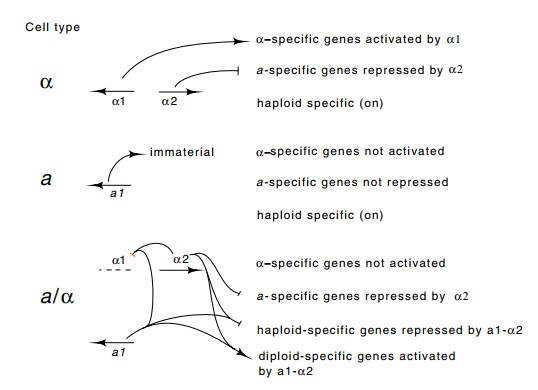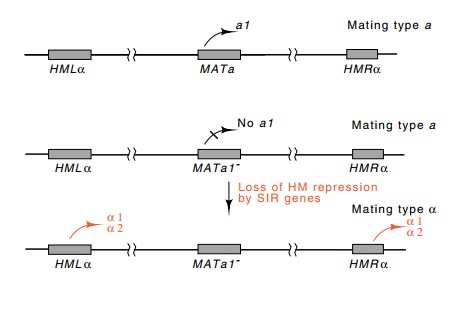Chapter: Genetics and Molecular Biology: Regulation of Mating Type in Yeast
Silencing HML and HMR
Silencing HML
and HMR
The roles of the mating-type genes have been
defined for cell-type determination. α1 is an
activator of α mating-type genes, α2 is a repressor of a mating-type genes, and a1
plays no role in haploid cells (Fig. 16.8). To generate the a and α mating types it would suffice if α1 product activated α type
genes, which otherwise would be off, and if α2 product repressed a type
genes, which otherwise would be on. This, however, would not provide for
correct expression in diploid cells where the haploid-specific genes must be
repressed and diploid-specific genes must be turned on. Genetic experiments
examining the expression of mating type-specific genes have revealed that in
addition to the pattern mentioned above, in diploid cells the a1 product and α2 product com-bine to form a repressor of haploid-specific genes and
activator of diploid-specific genes. Without such a repressor, α type genes would be expressed in diploids. One way
to start to work out the control circuitry is to isolate mutations that disrupt
the normal regulation patterns.
If proteins repress expression of genes located in HML and HMR, then mutations in such repressor proteins should permit
expression of mat-ing-type information from these loci. Such mutant cells could
behave as a/α diploids since they would express both a and α mating-type information
simultaneously if they had the two types of mating infor - mation at HML and HMR. As a result, they would be sterile for mating. Such mutants
have been found. A second approach to isolation of repression negative mutants
is to begin with cells that are HMLα-MATa-

Figure
16.8 The various gene activating and
repressing activities necessary toregulate a-
and α-specific, haploid-specific, and diploid-specific
genes in the three cell types of yeast. Note that α1 itself is a haploid-specific gene.
-HMRα (Fig. 16.9). Even though such cells express no
active mating-type information, they are of a
mating type by default. Now, if a mutant loses

Figure 16.9 Cells can
be made to switch mating type with the loss of repressionat HM loci if they possess an a1-
allele at MAT and cannot transfer
copies from HML or HMR to MAT. As a result they switch from constitutively expressing a type genes to repressing these genes
and expressing genes activated by α1.

Figure
16.10 Yeast of the genotype shown
containing a vector carryingHMLαare a
mating type unless a deletion enters the region necessary for repression of
expression from HMLα.
Cells possessing the necessary genotype were
mutagenized and colo-nies were screened for a shift from a to α mating type. This was a simple
replica plating assay for mating ability. Amongst the large number of
candidates screened, four repressor genes turned up. These are called the MAR or SIR genes. The existence of these genes and the behavior of strains
mutant in these genes proves that repression prevents expression of mating-type
genes at the HML and HMR loci.
The next question that can be asked about repression
of the mating-type information is where are the DNA sites that are required to
generate the repression? These must lie in the DNA sequences unique to the HML and HMR loci, for otherwise the repressor SIR genes would repress mating-type information at MAT as well. Precisely where they lie
could be found by deletion mapping. This was most easily done by placing an
entire HML or HMR region on a yeast shuttle vector which could be introduced into
yeast possessing essentially the same genotype as de-scribed above (Fig.
16.10). A deletion that eliminates repression of HMLαshifts the cell’s mating type
from a toα. Such sites lie on bothsides of HML
and both sides of HMR. Currently the
best guess as to the mechanism of action of silencing is that MAR or SIR gene products, histone, and other proteins organize the HM loci chromatin such that they are
inaccessible to RNA polymerase but accessible for interaction with the MAT locus for gene conversion.
Related Topics